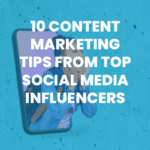Table of Contents
When I launched my own business in 2018, I was hit with a hard reality:
I had to do a lot of hard work just to make myself known.
Marketing took up a huge amount of my time and, for a while, made my new role as an entrepreneur feel very overwhelming.
This is a bit ironic, considering my business, Inkwell Content, is quite literally a marketing service. You’d think I, of all people, would know how much time and dedication it takes to successfully market a business.
Fortunately, I eventually figured out that to help my business thrive, I had to apply the same successful strategies I use for my clients to my own business.
In other words, I had to start leveraging my bread and butter, content marketing.
I’m happy to report that my business has been steadily growing since I got into the right marketing mindset. The strategies I’ve used to promote my solo business have paid off—2022 was my most successful year to date.
Now, I’m going to share some of those tips with you. If you aren’t using content marketing yet to grow your business, I guarantee these tips will get you ahead of the game.
What is content marketing?
Content marketing involves using text, imagery, video, and other digital assets to promote your business, expand your audience, and grow your customer or client base.
“Content” can refer to literally anything you create for your business. The text on your website, the posts you make on social media, the videos you create, the infographics and images you upload—all of that falls under the umbrella of content.
These digital assets are powerful tools—anyone can use them to deepen their connection with their audience and achieve their business goals.
Tip #1: Use social media as a testing ground
The key to successful content marketing is knowing what your audience wants most and delivering it through the right channels to reach them.
The best way to discover this is to speak directly to your audience and find out what excites them. And there’s no better place to do this than on social media.
Once you have a few ideas of the topics you want to discuss in your content, craft a few social media posts for the channels where your audience is most active.
Monitor the results of these posts. Some of your posts won’t perform well—and the beauty of social media is that posts that flopped will soon vanish from the top of your timeline.
But the posts that do get lots of likes, comments, and reshares should be moved on to the “next stage” of your content production. Take them and turn them into something more (see tip #3 for more on that).
Want more tips on using social media in your content strategy? Check out these articles:
Tip #2: Leverage partnerships for greater reach
Creating content without an audience can feel a bit like shouting into the void. What’s the point of putting in all that work to create something if no one is going to see it?
If growing your audience is your first priority, you can fast-track your content strategy by building partnerships with other entrepreneurs, businesses, and influencers who have already established an audience.
Landing partnerships takes a bit of work, but there’s a general process to it:
Generate a list of potential partners
These should be businesses or individuals who are not direct competitors but who share an audience with you.
For example, my target audience is businesses that need help with SEO and content creation. So I’ve partnered with business coaches, graphic designers, and writing platforms—none of them compete with me directly, but they all have audiences that mirror my own.
Build relationships with your leads
Once you have a list, you need to build relationships. This doesn’t mean sending them one email with a pitch for a partnership. You’ll have a much higher success rate by warming up your leads through genuine interaction. Listen to their podcast, read their blog, follow them on social media, and comment on their posts.
Pitch partnerships
Once you’ve cultivated a connection with the intended target, you can come forward with a partnership pitch that will be mutually exclusive. If you want access to their audience, offer them something their audience can use. This could be anything from a lesson you share on a podcast or webinar, or you could team up to create an ebook or course.
From there, it’s a matter of making sure you have a system in place to manage the traffic coming to your business after these appearances. A good email nurture sequence is a great start.
Tip #3: Repurpose everything you make
Creating content takes a lot of time. But with a bit of strategy, you can significantly cut down how much of your day you have to devote to content marketing.
Repurposing content means using one piece of content in multiple ways across multiple platforms. There are hundreds of different ways you can do this, but here’s an example:
- You write a post on LinkedIn that gets lots of good engagement
- You take that post and turn it into a blog for your website
- You create a few images to go along with that blog
- You post those images to your Instagram account
- You share the blog and images with your mailing list
- A month later, you record an interview with an expert on the topic
- You integrate that video into your existing blog
- You share clips of the interview on social media
- You turn the interview into a podcast
With a process like this, you’ve taken one single piece of content and turned it into several different assets. You’ve shared it in multiple different formats and on different channels, maximizing the number of people who will see it.
This strategy works much more efficiently and effectively than scattershot content, so plan ahead whenever you’re in creation mode to save yourself time.
Tip #4: Use AI as a tool (not a crutch)
Unless you’ve been living off the grid, you’ve heard a lot about how AI tools like ChatGPT are shaking up just about every industry.
And I’d be lying if I said I wasn’t a little concerned that these bots were eventually going to take my job.
I asked #ChatGPT to write a Twitter thread about its own impact on the #SEO industry. Here’s what it said:
— Liam Carnahan | SEO Freelance Coach (He/Him) (@liamcarnahan) December 16, 2022
But the truth is, there are a lot of tools out there that can help you speed up the process of content creation. ChatGPT can help you generate ideas and build outlines for blog articles. AI tools can create nice imagery and write accompanying captions for social media.
There are also heaps of tools with built-in AI. StoryChief can help you write and promote written content, Canva’s AI can help you design branded assets, and tools like Surfer SEO can help you improve your search visibility.
You can and should use these tools to improve your content production—but don’t rely on them too much. These tools are still new (and far from perfect). They produce factual inaccuracies, don’t always sound human, and sometimes commit plagiarism.
Think of AI tools as an assistant to help you do your work faster and more efficiently, not as an easy way to automate the humanity that’s core to any healthy content strategy.
Tip #5: Brush up on SEO best practices
Search Engine Optimization, or SEO, is one of those aspects of content marketing that sounds more complicated than it is.
At its core, SEO is about making your content easy to find on search engines like Google. The majority of good SEO is about creating high-quality, informative content that’s relevant to your business. So if you’re already doing that, you’re 90% of the way there.
The other 10% has to do with how you present your content on your website. Things like metadata, site speed, and backlinks all play a factor in whether the content you create will show up when your audience types in a question on Google.
That’s why it’s important to learn at least the basics of SEO. And luckily, there are many easy and affordable (or even free) ways to do just that.
In fact, I have a course that teaches SEO fundamentals. It takes less than an hour to complete, and it’s free right here:
Tip #6: Ask your audience for content ideas
Consistently creating engaging content is no easy task. Every content creator will come to a point when they are simply out of ideas and aren’t sure what to discuss next in the content they create.
When this happens, the best thing you can do is reach out to your audience to find out exactly what they want to hear about. You can do this in a number of different ways:
- Ask your social media followers what they want to learn about
- Poll your audience via email or social media with a few potential topics
- Look at competitors for inspiration to find out what’s working for their audience
- Review common questions about your industry on Reddit or Quora
- Ask your sales team or customer service team what kinds of questions they’re getting all the time
By sourcing ideas directly from your audience, you’re not only expanding your list of potential topics, but you’re also guaranteeing that what you’re producing will resonate with your audience.
Tip#7: Focus on a robust promotion strategy
Creating content is just the tip of the iceberg—without a strong promotion strategy in place, you won’t get nearly as much traction.
A promotion strategy cannot be limited to simply tweeting out links to your new blog every once in a while. While this is not necessarily a bad thing to do, you’ll have a hard time reaching the right audience with such basic measures.
There are many ways to improve the promotion and distribution of your content:
- Use some of your budget for paid promotions on social media to expand your reach
- Enlist the help of a PR agency that can spread the word
- Partner with popular blogs and guest-publish content
- Join podcasts and webinars where you can promote your content
- Spend time cultivating an email list of people who enjoy your content
Any of these efforts will improve the ROI of your content marketing. You’ll reach wider audiences, and the benefits will only grow as more people share your content with their own fans and followers.
Content marketing is one of the most effective strategies for growing businesses. Even if you’re a single-person operation, you can use written word and visual content to spread the word about your business and bring your revenue to new heights.








